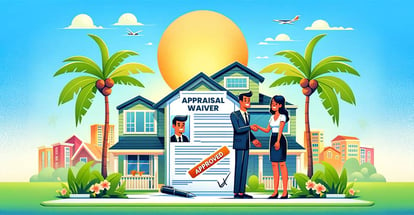FHA vs Conventional: Why the Lower Rate Doesn’t Always Mean the Better Deal
If you’ve been shopping for a mortgage and have less-than-perfect credit, you might notice something surprising: FHA loans often come with lower interest rates than conventional ones.
That might seem backwards — shouldn’t lower credit mean higher rates?
Check Your Florida Home Purchase Eligibility
In this article, we’ll break down why FHA loans are priced lower, how the government’s backing plays a role, and when conventional loans might still be the better long-term option.
In this article (Skip to...)
FHA vs. Conventional Loan Basics
Before we get into why FHA rates are usually lower, it’s important to know how these two loan types work.
FHA loans are backed by the government, which makes them less risky for lenders. That’s why they’re easier to qualify for especially if you have a lower credit score or a small down payment.
Conventional loans are backed by private lenders and sold to Fannie Mae or Freddie Mac. They come with stricter credit and income requirements, but they offer more flexibility later like the option to remove mortgage insurance.
Both are solid options, but for buyers with average or below-average credit, FHA often starts off with the lower interest rate.
Check Your Florida Home Purchase Eligibility
_and_Conventional_mortgage_loans_in_two_sections-min%20(1).png?width=1536&height=1024&name=A_2D_digital_infographic_compares_FHA_(Federal_Housing_Administration)_and_Conventional_mortgage_loans_in_two_sections-min%20(1).png)
Why FHA Interest Rates Are Often Lower
You might expect mortgage rates to rise sharply if your credit score is below 700 and with conventional loans, that’s usually true. But FHA loans are structured differently.
Because FHA loans are backed by the federal government (via HUD), lenders take on much less risk.
That safety net allows them to offer lower interest rates, even to buyers with credit scores in the low 600s.
And unlike conventional loans, FHA pricing doesn’t change much based on your credit score or down payment size.
FHA loans are also bundled into Ginnie Mae securities, which investors consider ultra-safe. This strong investor demand pushes rates even lower for FHA borrowers.
Take a look at how current FHA and conventional rates compare across different credit scores:
| Credit Score | FHA Rate (Flat Pricing) |
Conventional (With LLPAs) |
Conventional (LLPA Waiver*) |
|---|---|---|---|
| 660 | 6.70% | 7.61% | 6.70% (matches FHA) |
| 700 | 6.70% | 7.45% | 6.50–6.60% (lower than FHA) |
| 740 | 6.70% | 7.24% | 6.40–6.50% (best option) |
Conventional Loans Can Be More Expensive But Only at First
Conventional loans are priced differently than FHA loans and that’s where things can get confusing.
Instead of using a flat insurance model like FHA, conventional lenders apply Loan-Level Price Adjustments (LLPAs).
These are essentially risk-based fees that increase your rate or closing costs based on your credit score, down payment, property type, and more.
For buyers with excellent credit, LLPAs are minimal or nonexistent.
But for buyers with lower credit especially under 700 LLPAs can add up fast. A borrower with a 660 score might face 1.5% or more in penalties, which can either:
-
Raise their interest rate by 0.50%–0.75%, or
-
Add thousands to their upfront costs
This pricing model is why conventional loans often look worse at first glance for lower-credit buyers but that can change with the right programs.
Let’s look at how certain conventional loans eliminate these penalties entirely.
Check Your Florida Home Purchase Eligibility
How LLPA Waivers Make Conventional Loans a Better Deal Than FHA
Here’s where conventional loans go from “too expensive” to surprisingly competitive even for buyers with credit scores in the low 600s.
Programs like HomeReady, Home Possible, and UWM’s 1% Down waive many or all of the LLPAs that normally drive conventional rates higher.
That means borrowers who would’ve been penalized for a low credit score or small down payment can now get rates on par with or even better than FHA.
But the benefits go beyond just the interest rate:
-
No upfront mortgage insurance (unlike FHA’s 1.75% UFMIP)
-
PMI can be canceled once you reach 20% equity
-
Grants and lender credits can reduce your cash to close
With LLPA waivers in play, a well-structured conventional loan can beat FHA on both monthly cost and long-term savings especially for buyers between 640 and 680 FICO.
Let’s break it down with a real-world scenario:
Loan Option Comparison Based on a Credit Score of 640.
| Loan Type | Rate | Monthly MI | Total Monthly | Notes |
|---|---|---|---|---|
| FHA | 6.25% | $175 | $2,022 | MI lasts for life |
| Conv (w/ LLPA) | 7.25% | $110 | $2,110 | Higher rate, cheaper MI |
| Conv (w/ Waiver) | 6.25% | $110 | $1,927 | Best Case |
How HomeReady, Home Possible, and UWM 1% Down Compete With (and Sometimes Beat) FHA
FHA loans are popular for a reason, they’re flexible and accessible.
But they’re not the only option for buyers with low credit or limited savings.
Conventional loan programs like HomeReady, Home Possible, and UWM’s 1% Down are designed to offer similar upfront affordability, without the permanent mortgage insurance or strict property rules that come with FHA.
Here’s how each program works:
UWM’s 1% Down Program
-
Minimum borrower contribution: 1%
-
Lender contribution: 2% grant (up to $7,000)
-
Income limits: ≤80% AMI
-
Credit score minimum: 620
-
Loan type: Conventional (97% LTV)
-
LLPAs waived: Yes (when paired with HomeReady or Home Possible overlays)
-
Mortgage insurance: Cancelable
Why it beats FHA: You put less down and avoid FHA’s lifetime mortgage insurance — a huge win.
Check Your Florida Home Purchase Eligibility
HomeReady (by Fannie Mae)
-
Minimum down payment: 3%
-
Income limits: ≤80% of Area Median Income (AMI)
-
Credit score minimum: Typically 620+
-
LLPAs waived: Yes — for eligible borrowers
-
Mortgage insurance: Required, but can be removed once you reach 20% equity
-
Extras: Can use income from household members (even if they’re not on the loan)
Why it beats FHA: You avoid the 1.75% upfront FHA mortgage insurance and can remove monthly PMI down the road.
Home Possible (by Freddie Mac)
-
Minimum down payment: 3%
-
Income limits: ≤80% AMI
-
Credit score minimum: Typically 620+
-
LLPAs waived: Yes — for eligible borrowers
-
Mortgage insurance: Cancelable
-
Extras: More flexibility with non-borrower income and co-borrowers
Why it beats FHA: Very similar to HomeReady, but often better for multi-generational households or when using co-borrowers.
Check Your Florida Home Purchase Eligibility
Final Thought: Compare the Full Picture, Not Just the Rate
It’s easy to focus on the interest rate but that’s only one piece of the puzzle.
Monthly payments, upfront costs, mortgage insurance, and long-term flexibility all play a role in your total cost of homeownership.
In many cases, a conventional loan with a slightly higher rate can actually save you more over time by avoiding FHA’s lifetime mortgage insurance.
And in others, FHA’s simpler structure and lower entry costs make it the smarter choice.
Contact MakeFloridaYourHome to see which loan type makes more sense for your unique situation.
With over 50 years of mortgage industry experience, we are here to help you achieve the American dream of owning a home. We strive to provide the best education before, during, and after you buy a home. Our advice is based on experience with Phil Ganz and Team closing over One billion dollars and helping countless families.

About Author - Phil Ganz
Phil Ganz has over 20+ years of experience in the residential financing space. With over a billion dollars of funded loans, Phil helps homebuyers configure the perfect mortgage plan. Whether it's your first home, a complex multiple-property purchase, or anything in between, Phil has the experience to help you achieve your goals.
 By
By  Edited by
Edited by 





